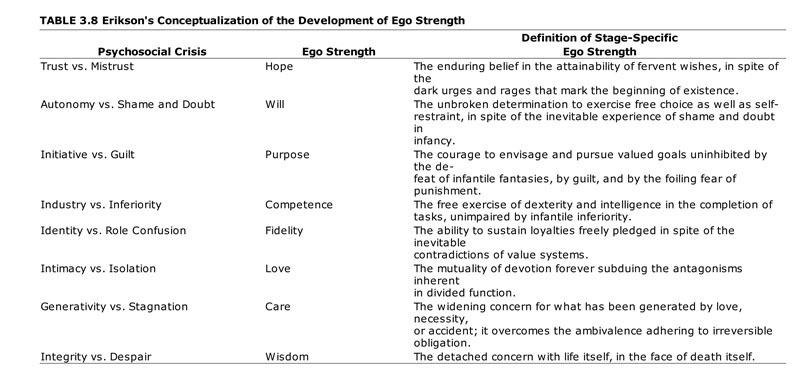| << Chapter < Page | Chapter >> Page > |

What I am going to do now is provide an integrative analysis of the last few sections which were Maslow's Needs, the peripherial variables that affect the social process, and Erikson's Psychosocial stages. First off people have basic needs such as listed by Maslow - physiological, safety, love and belongingness, esteem, and self-actualization needs. All of those are important to social interaction but they need to be considered in a larger psychological context. People want to feel good about themselves and achieve self-actualization, but they can do that through the discovery of Erikson's Psychosocial Crisis. Trust, shame, guilt, inferiority, identity, intimacy, generativity, and integrity (some of the factors Erikson mentioned) all are components in the social process, and they all relate to Maslow's Needs. This is so because in any interaction there is a deeper reflection of the self that occurs. Your primary motivations (Maslow's needs) seeks introspection and development in Erickson's psychosocial crisis (for instance, you seek belongingness (Maslows need) through the development of trust (Ericksons stage)). In addition, there are the peripheral variables of dependency, abasement, approval, authoritarianism, order, affiliation, machiavellianism, dominance, nurturance, achievement, and recognition.
On one hand someone could say about life or this book, "life isn't complicated - I don't need to know all this stuff about social interaction". On the other hand, when one thinks more deeply and clearly it becomes obvious that there are many factors present in social situations that could use reflection. You need to understand how you are behaving, you need to notice how the other person is behaving, and you need to do this on a moment by moment basis. You need to come to conclusions based on that observation as well - potentially a lot of conclusions. You might need to modify your behavior based on your observation of the other person and the conclusions you reach. Furthermore, you need to notice the effect of this behavior on each person, on their emotions, and on the mood of the situation. One person might want the other person to like them, and is concerned with the attitudes, emotions, and types of understand the other person may have. The mood of a situation can vary from painful, difficult and not funny to humorous, joyful, and exciting. People could be getting along as equals, with shared understanding, or one person could be trying to dominate the other. The dominant person might also be getting along as a subordinate at the same time. The conclusions you reach, your attempt to modify your own behavior, your goals and motivations as a result of the presence of the other person, the mood and the emotions involved (pleasurable, painful, or others) and the type of relationship (dominant, subordinate, friendly) are all powerful and key forces involved in social interaction and worthy of conscious reflection.
Someone could also say, "there is an amazing amount of information and complexity involved in life and in social interaction, the emotions involved are powerful and real". But what is this complexity and how do you notice when the emotions are present? Is there a simply way of describing the complexity, of summing it up? You can read this book and this chapter especially, that is the long version of the complexity involved. However it would be nice to have a more simple understanding for quick review. There are many different types of social situations that people can find themselves in. The location, people involved, and the setting are all factors that have a lot options and change the nature of the interaction in many ways (creating a lot of variety). You have to perform differently in each different situation and function at a high level each time. You have to be aware of the situation, of the behavior, emotions, attitude, mood, understanding, role, motivation, and needs of the people involved. Because of these factors (also the characteristics of the people, and if there is a conversation) there is a certain mood in every social situation - this mood would obviously be very complicated considering the number of contributing factors. Moods, therefore, are a lot more complex than just "happy" or "sad" or "angry" - there are tones and subtleties to situations and interactions that contribute to the feelings and atmosphere (or "mood") present (it is a created environment - created by complex psychological factors (which are the thoughts of each person, their motivations, attitudes, feelings, personal characteristics, other circumstantial factors (the environment, setting, etc), and -- obviously -- their behaviors)).

Notification Switch
Would you like to follow the 'Emotion, cognition, and social interaction - information from psychology and new ideas topics self help' conversation and receive update notifications?